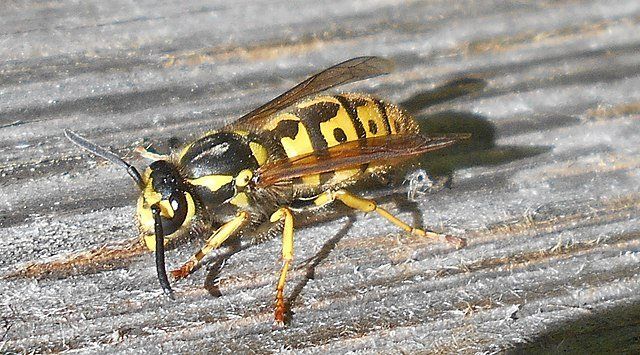-- Pest Library --
Yellow Jacket
Yellow Jacket Description
Adults are smooth with yellow and black bands of color. The queen is about 3/4˝ long, and the workers are about 1/2˝ long. In general, yellow jackets are stout, big-bodied wasps. Yellow jackets can be easily distinguished from bees because they have relatively few body hairs and a distinct waist. Compared to honey bees, yellow jackets are sparsely haired. Wings are folded lengthwise, similar to paper wasps and hornets.
Diet
Yellow jackets are scavengers and will feed on various insects, fruits, meats, sweets, flies, and caterpillars. Adults are highly attracted to sugar in fruits, soda cans and candy, and will seek out items rich in carbohydrates. Adults will seek out protein to bring back to the nest and feed growing larvae.
Life Cycle & Reproduction
The queen will lay a few dozen eggs and nurture them until they mature. The queen only cares for the first brood and then depends on the workers to build new paper cells and search for food. After the first dozen workers mature, the queen will specialize in egg production to expand the colony. The workers will care for the larvae and pupae (immature wasps) and will feed and care for the queen. During the summer months the workers will reach their peak population. Colonies can quickly build up to over 10,000 members in just one summer. The males and worker yellow jackets die off and the fertilized queen seeks a place to hibernate through winter. Queens survive the winter in sheltered locations like buildings or outdoors under bark, stones, loose leaves or other shelter. In the spring the cycle begins again.
Habitat
Queens prefer to build underground nests and will take advantage of abandoned rodent burrows. They will also start nests in wall voids or empty roof space. Yellow jackets will chew wood fiber, such as wood fencing, into a pulp to build their nest. Yellow jackets are social insects, living in colonies of hundreds to thousands.
Threat
Like other social wasps, yellow jackets vigorously defend their nest against threats, such as people who get too close to the nest entrance. Guard wasps stationed near nest entrances use chemical communication to warn the colony of intruders. Hundreds or thousands of wasps can quickly emerge from a nest and attack people or animals that venture too close. Yellow jackets tend to be more aggressive than other social wasps and bees. Adults will defend the colony without much provocation and sting if threatened. Yellow jackets are especially aggressive during the day when searching for food. Yellow jackets can sting repeatedly. Stings typically cause localized pain and swelling, but in sensitive individuals or when many stings occur (as with most arthropod stings) whole body (systemic) effects can occur including allergic reactions that may result in death.










